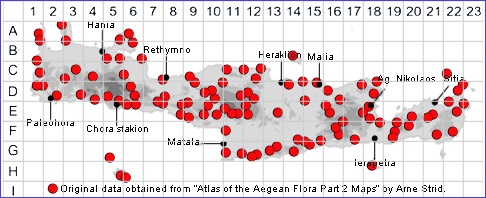
CREPIS TYBAKIENSIS
Family:- COMPOSITAE/Sect. NEMAUCHENES
Common Names:- None
Synonyms:- Crepis flexicaulis
Meaning:- Crepis (Gr) A name used by Greek philosopher Theophrastus.
Tybakiensis (L) For the locality in S Crete Timbaki (Timpaki).
General description:- Perennials.
Stems:- Several, up to 15 cm, simple.
Leaves:-
1) up to 7 x 1 cm, all basal, numerous, oblong to obovate-lanceolate,
subentire to pinnatisect.
2) Lateral lobes triangular, acute, remotely denticulate.
3) Terminal ovate-hastate, glabrous or with a few eglandular hairs.
Flowers:-
1) Capitulum solitary, shortly setulose.
2) Involucre 6-12 x 5-8 mm.
a) outer bracts, lanceolate. c.1/3 as long as the inner.
b) inner, linear-lanceolate, with eglandular and shorter glandular hairs
or glabrescent.
3) Ligules yellow, reddish-purple on outer face.
Fruit:-
1) Achenes, fusiform, of 2 kinds:
a) marginal 6-8 mm, strongly curved, the body equalling the beak, with densely
spinulose, obscure ribs.
b) inner 10-12 mm, the beak 2½ times as long as the body and extremely
slender, with 10 spinulose ribs.
Key features:-
1) Stems numerous, each with a single capitulum.
2) Achenes less than 12 mm.
3) Inner achenes 2-7·5(-9) mm.
4) Cauline leaves filiform, bract-like.
Habitat:- In a variety of dry, open, rocky and stony habitats, dolines, etc. 0-1500 m.
Distribution:- Endemic to Crete and Karpathos. Widespread on Crete.
A report (2014) from the foothills of Mt Kerkis in Samos may cast some doubt on
this.
Flowering time:- Mid-Apr to June.
Photos by:- Zacharias Angourakis
Status:-
Protection status (for threatened species):- Greek Presidential Decree 67/1981.
SPECIES DESCRIPTION
